The information below has been sourced from the website taungurung.net/culture
This was based on information collected and published in ‘Australian Natural History,’ June 1962, by Aldo Massola, former Curator of Anthropology, National Museum of Victoria.
 Burngeet (Baangiit)
Burngeet (Baangiit)
This war boomerang does not return but was thrown straight at the enemy and parried with the shield. A competent thrower could make it strike the ground, rebound, and hit the enemy. Thrown in this way it was much more difficult to dodge.
 Geam or Geeam (Giam)
Geam or Geeam (Giam)
This large shield was used as a protection against long spears. Commonly made from the inner bark of Eucalyptus viminalis - Manna Gum. Two types of this shield exist, the difference being in the handle. In one, the handle is cut from the solid, while in the other it’s made of a separate piece of green wood which is thrust in two bored holes and is then almost impossible to remove.
Hearth
An oven made by digging a hole in the ground, then lined with stones along the bottom. A fire is made and once the stones and judged sufficiently hot enough, the fire is removed and the animal to be cooked is placed and covered within.
 Kannan (Ganan)
Kannan (Ganan)
A woman's digging stick made from any suitable sapling sharpened at both ends and hardened over a fire. Principally used for digging roots and small animals from the soil, but could also be used for fighting.
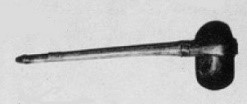 Karagik (Gaagik)
Karagik (Gaagik)
The handle of this stone-headed axe was a length of tough sapling, split and bent around the head. It was tied near the head and at the distal end with the fibre from a stringy-bark tree, or the sinews of the tail of the kangaroo and further secured by gum.
 Konnung
Konnung
This fighting stick was sharpened at both ends and used in close combat where it was held in the middle and used for stabbing.
 Koorngoon (Dhaalgalk)
Koorngoon (Dhaalgalk)
Made from resonant wood, they are commonly known as clap sticks. The sticks were struck against one another to keep time or emphasize dance steps or songs for corroborees.
 Koy-yun (Guyon)
Koy-yun (Guyon)
A hunting or war spear. This weapon was fashioned with great care. It had to be very straight and the point had to be very smooth and sharp. It was not barbed and was thrown by hand.
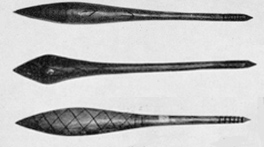 Kudgerin or Kudjeroong (Gudjerron)
Kudgerin or Kudjeroong (Gudjerron)
A thick very weighty club or waddy with a bulbous round head used mainly in single combat when both combatants protected themselves with the wooden shield (mulga). Blows were only aimed at the head and it would have been deemed unfair to strike at any other part of the body. Other forms of this weapon have an oval head in cross-section or the head was flattened to the extent of producing two blunt cutting edges.
 Kurruk or Murriwan (Garrick or Marriwan)
Kurruk or Murriwan (Garrick or Marriwan)
A spear-thrower which enabled spears to be thrown with much greater force and accuracy. Spear-throwers had a tip which fitted into the hollow at the butt end of the spear. Two types were used: one in which the barb was cut out of the solid timber while the other sort, the barb was made from a fragment of bone, lashed on with native string secured with gum.
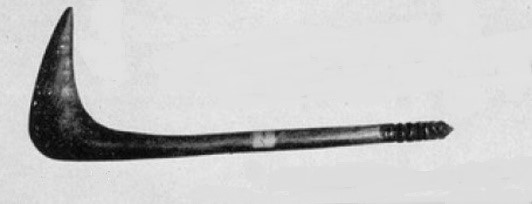 Leonile (Li-angiyl)
Leonile (Li-angiyl)
The Leonile was made of hard, heavy wood and was a dreadful hand weapon. A curved root was chosen which could withstand a heavy blow without splitting. The weapon was employed in single combat in the same way as the Kudjeroong but it was reported to be more dangerous as the curve enabled the point to get over the protection of a shield.
 Mongile (Mongiyl)
Mongile (Mongiyl)
This jagged war spear was thrown by hand and was greatly feared because of the nature of the wound they inflicted. A long groove was cut on each side of the point along the shaft. Embedded into the groove were sharp chips of quartz secured with gum.
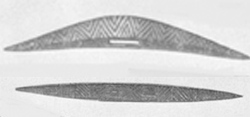 Mulga or Drunmung
Mulga or Drunmung
This shield was used in single combat to defend the head from the hand clubs. Its wedge-shape presented a very sharp edge to ward off incoming blows.
 Nandum (Nandam)
Nandum (Nandam)
Made from a single length of hard wood, this jagged war spear was a dreadful weapon. The spear was not thrown with the spear-thrower.
Scar Tree
These are trees which have had bark removed for the creation of bark canoes, shelters, shields and containers.
 Stone chisel (Bi-am Bi-am)
Stone chisel (Bi-am Bi-am)
Used to manufacture wooden implements this tool consisted of a large sharpened flake of hard grounded stone, such as basalt, set into a cleft stick which was then held in position by a ligature of native string.
 Tare (Dari)
Tare (Dari)
A long pointed spear was thrown with a spear-thrower and mainly used for distant warfare.
 Tirrer (Djirra)
Tirrer (Djirra)
The upper part of this spear consisted of a shaft of hard, heavy wood, with a series of barbs cut along one side of the point. The heavy wooden shaft was inserted into a reed, where it was securely fastened with native string and gum. This spear was thrown with a spear-thrower for distant objects.
 Small Prey Noose
Small Prey Noose
Made from two long wooden rods, fitted to a central section of reed gave the unit great flexibility. A noose of native string was fitted to one end of the rod to enable the hunter, hidden behind some bushes, to slip the noose over the head of a bird, with a quick jerk.
 Wit-wit
Wit-wit
A plaything made from a sapling with the head being part of the root. When it was skimmed along the ground, the thrower could make it leap from spot to spot for nearly 200 meters.
 Wormegoran
Wormegoran
This two-pronged spear was used for catching fish.
 Worra Worra (Warro Warro)
Worra Worra (Warro Warro)
A throwing stick/club used in single combat fighting and hunting game. It was generally made from the root of a tea-tree (Melaleuca ericifolia) sapling.
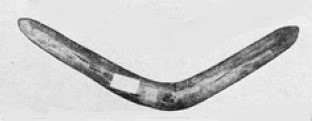 Wouguim or Wonguin (Wanggim)
Wouguim or Wonguin (Wanggim)
Believed to have been thrown in battle, it was also used to knock down birds, throwing practice and when properly thrown, came back to the thrower.
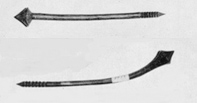 Yeamberrn
Yeamberrn
Although sometimes thrown so the sharp point entered the body of the enemy, this weapon was usually used in hand-to-hand combat.
*The Taungurung Clans Aboriginal Corporation holds the copyright to all cultural material on behalf of the Taungurung Nation.
